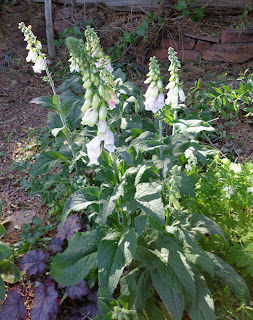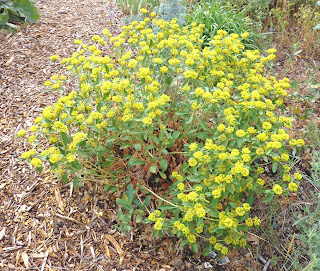In our gorgeous, biodiverse, and blessed land where so many fine people seem to be passionate about possessing, "bearing" or otherwise abusing firearms, I have an excellent substitution for them. Somewhere in The Essential Earthman, Henry Mitchell translates bombyciferum (in reference to the Dolly Parton of mulleins) as "carrying a bomb": there is certainly something incendiary, outrageous and explosive about verbascums. Not a few are bona fide (albeit lovely in a fashion) weeds. Many if not most are massive and create problems with disposing of their bodies (like the year I grew two or three hundred: where to dump so many almost human sized corpses?) (P.S. you should click on the picture above to get a PROPER view of my harem early in late May)...
So what better way to indulge your slightly sociopathic urges, (if not altogether psychopathic) than to grow verbascums? That must explain my passion for these wooly monsters: I have grown dozens of species in my day. There are hundreds and hundreds of them--mostly concentrated in Greece and Turkey (interesting fact that). They are ridiculously variable as a genus: tiny little Verbascum acaule is a Greek alpine only a few inches tall and broad. And they can come in velvety purple and nearly pink flower color as well as startling white.
But this is everyone's favorite (including mine): Verbascum bombyciferum really means "bearing wool", and the young leaves and especially the flower stalks are wonderfully velvety wooly white. It apparently is largely restricted to the Bithynian Olympus (nowadays called Ulu Dag) not far from Proussa (nowadays Bursa), a few hour's drive south of Constantinople (yes, I know: Istanbul). I had distant ancestors who hailed from these regions, and used the Greek names, and a touch of sentimentality suggests to me that they might have stumbled upon this in their Ionian wanderings. The flowers are much bigger than this picture suggests: two inches or so across, and they are abuzz with bees in the morning.
The first picture in this series was taken almost two months ago: look how they have grown! and continue blooming and blooming: there are many reasons to be grateful of having a large garden, and for me chief among these is that I can have verbascums self sow liberally and not have to worry too much about it. I do weed out many of the rosettes (hundreds of carcases eventually get depressing to remove and stash)...but I leave plenty for the amusement of my guests (and of myself)...
They are lovely any time of day, but in the early morning, when they postively glow in the dawn light, I am transfixed as I wander through my miniforest of wooly towers, like an oversized bee.
I have had sputtering nativists scold me for my love of mullein. I smile and commend their commitment to a noble cause (I love my natives too: monogamy is well and good for mere humans, but we plant Gods want a sizeable harem of our vegetable goddesses). "My vegetable love shall grow/vaster than empires and more slow" says Andrew Marvell. Genghis Khan has 600 human wives, after all: will you begrudge me my 6000 chlorophilic concubines?
This Olympic Mullein inspires hyperbole and endless love (from some of us). I have lots of seed to spare, b.t.w. (although often including hybrids with the dozen or so other species I also grow in my garden--sharp eyes should have picked one up in this last picture).
Now if we can only get the N.R.A. to cotton on to mulleins...










































